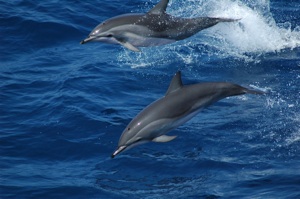Marine Mammal Species Description
Clymene Dolphin
Stenella clymene
(Gray, 1850)

Photo credit: Wayne Hoggard NOAA/NMFS/SEFSC
Classification
Order: Cetacea
Family: Delphinidae
Alternate Common Names: Helmet dolphin, short-snouted spinner dolphin
Status: protected under MMPA
Description:
Length: 5.5-6.5 ft (1.7-2 m)
Weight: 165-187 lbs (75-85 kg)
Adult Clymene dolphins have a moderate length beak and a long slightly falcate dorsal fin. They have a crease that separates the beak and the melon. They are dark gray above, light gray on the sides, and have a white belly. Some individuals have a dark stripe on its beak that looks like a 'moustache.'
Habitat:
Clymene dolphins occur in warm temperature, deep water from 820-16,400 ft (250-5,000 m) depth. They have been recorded in shallower areas but generally, they seem to prefer deeper water. Groups of 2-50 Clymene dolphins have been recorded in a school. These groups may be segregated by sex and possibly age. Some documentation of strandings show groups being almost all males or almost all females.
Feeding:
Clymene dolphins feed on fish and squid. There is at least one record of these dolphins cooperating to herd schools of fish during feeding.
Reproduction:
Adult Clymene dolphins reach sexual maturity when they reach the size of approximately 6 ft (1.8 m). Females give birth to a single calf. Little is known about the reproductive characteristics of Clymene dolphins, but they are probably similar that of other species of Stenella.
Other:
This species is an occasional victim of cookie cutter sharks (Isistius brasiliensis). The feeding of the shark leaves small, circular scars on of many species of marine mammals.
Distribution / Range:
The Clymene dolphin occurs in the tropical and subtropical waters of the Atlantic Ocean. It has been recorded in areas off the coast of New Jersey, United States south to Brazil including the Gulf of Mexico and the Caribbean. Most individuals probably do not occur farther north than the coastal area off North Carolina.
Similar species:
Similar species include the common dolphin (Delphinus delphis) and the spinner dolphin (Stenella longirostris).
Notes:
References:
Culik, B. 2010. Odontocetes. The toothed whales: "Stenella clymene". UNEP/CMS Secretariat, Bonn, Germany. http://www.cms.int/reports/small_cetaceans/index.htm. Accessed January 2012.
Hammond, P.S., Bearzi, G., Bjørge, A., Forney, K., Karczmarski, L., Kasuya, T., Perrin, W.F., Scott, M.D., Wang, J.Y., Wells, R.S. & Wilson, B. 2008. Stenella clymene. In: IUCN 2011. IUCN Red List of Threatened Species. Version 2011.2. www.iucnredlist.org. Downloaded on 09 January 2012.
Jefferson, T.A. 2009. Clymene Dolphin - Stenella clymene. In: Encyclopedia of Marine Mammals 2nd Ed. Perrin W.F., B. Würsig, and J.G.M. Thewissen, eds. Academic Press, New York, pp. 241-243.
Perrin, W.F. 1999. Clymene dolphin, Stenella clymene. In The Smithsonian Book of North American Mammals. Wilson, D.E. and S. Ruff, eds., 267-268. Smithsonian Institution in association with the American Society of Mammologists, Washington DC.

 Marine Mammals of Georgia
Marine Mammals of Georgia